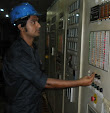Flame Detector
A flame detector is a fire protection device,used to detect flame.Generally flame detectors are two types, optical flame detector or Photoelectric Detectors and flame ionization detector. In some situation used combination of both detectors. Flame detector works at specific ranges, uses optical sensors to record the incoming radiation at a particular wavelength.
Ionization detectors consist of two parts, an ionization chamber and a ionizing radiation source.The ionization chamber consists of two plates positioning about 1cm apart.The battery applies a voltage to the plates, charging one plate positive(+ve) and the other plate negative(-ve).
Ionization detectors
Ionization detectors consist of two parts, an ionization chamber and a ionizing radiation source.The ionization chamber consists of two plates positioning about 1cm apart.The battery applies a voltage to the plates, charging one plate positive(+ve) and the other plate negative(-ve).
Ionizing radiation is a minute quantity of americium-241 (about 1/5000th of a gram),used as a source of alpha particles.
"The mobility of the O2+ ion, extrapolated to zero E/P0, was 2.4 cm2/Vsec while that of the nitrogen ion, identified as N4+, was 2.6 cm2/Vsec."
Alpha particles constantly released by the americium knock electrons off of the atoms in the air, ionizing the oxygen(O2+) and nitrogen(N4+) atoms in the chamber. The positively-charged(+) oxygen and nitrogen atoms are attracted to the negative plate and the electrons(e-) are attracted to the positive plate and generate small, continuous electric current.
If smoke enters the ionization chamber then the particles attach to the ions and neutralize them and they can't reach the plate. The drop in current between the plates promote the alarm system
Photoelectric Detectors
In photoelectric system when smoke entered in a T-shaped chamber fitted with a light-emitting diode (LED) and a photocell. The LED sends a beams of light across the horizontal tube of the chamber. The photocell sets at the bottom of the vertical section of the chamber. The photo cell produce a current if exposed to light.
When there is no smoke,the light beam crosses the top of the T in an uninterrupted straight line, not reaches to the photocell positioned at a right angle below the beam. When smoke is present, the light is scattered by smoke particles, and some of the light is directed down the vertical part of the T to strike the photocell. When sufficient light enterend the cell, the current promote the alarm system.












